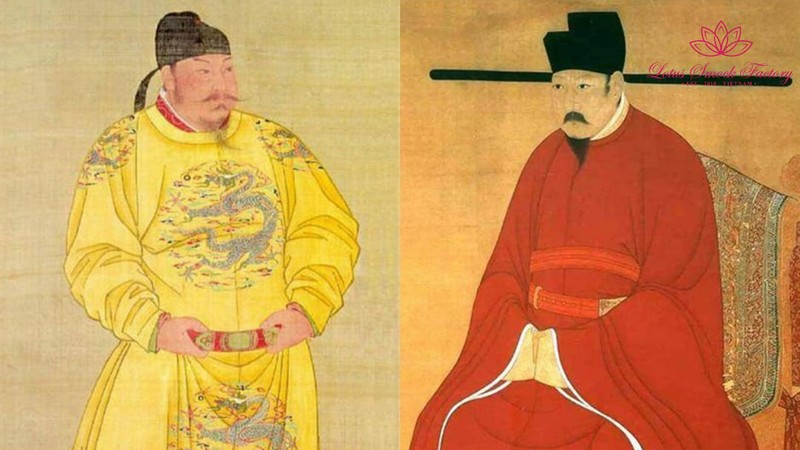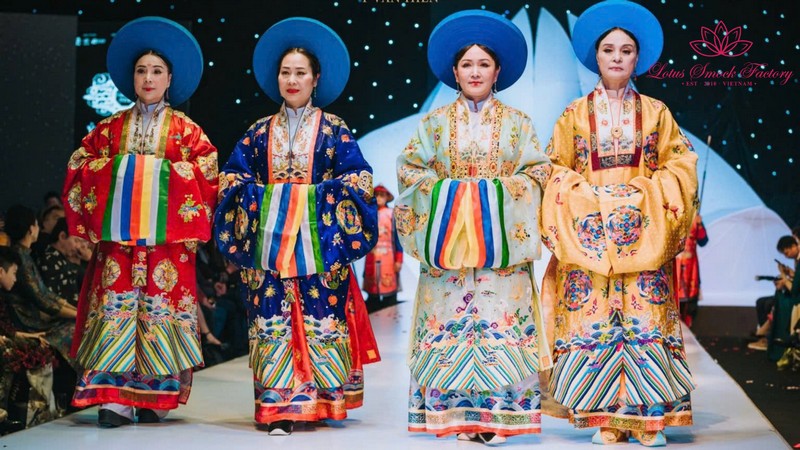Vietnamese Hand Embroidery: 1000 Years of Craftsmanship
Vietnamese hand embroidery is more than just a craft; it’s a timeless tradition that has woven itself into the fabric of the nation’s history, culture, and identity. From the royal courts of ancient dynasties to modern-day fashion runways, this intricate art form has evolved while maintaining its unmatched beauty and craftsmanship. Let’s take a journey through the rich development of Vietnamese hand embroidery and its enduring significance today.

1. The Development Process of Hand Embroidery
Hand embroidery in Vietnam has a history that spans over a thousand years, shaped by cultural exchanges, dynastic influences, and the artistic innovations of countless generations. This art form started as a humble craft and transformed into a symbol of national pride.
1.1. The Role of Hand Embroidery in Feudal Dynasties
The art of hand embroidery in Vietnam has deep roots, tracing back over a thousand years to the era of the Hung Kings. Initially, embroidery was prevalent in the everyday lives of the common people but quickly evolved into a significant aspect of royal culture and ceremonial practices. Notably, during the Le Dynasty, the craft was advanced by “the father of embroidery,” Le Cong Hanh, who disseminated this art form in his hometown of Quat Dong, making it one of the first traditional embroidery villages in the country. This time-honored tradition has been preserved and passed down through generations, accumulating the expertise of countless artisans over the centuries.
Throughout the feudal period, hand embroidery was not only utilized in everyday items but also significantly developed to cater to the royal court and the elite. Exquisite embroidered products such as the long robe for emperors (long bào), ceremonial garments, flags, and decorative cloths were crafted with intricate motifs featuring flowers, leaves, animals, and scenes of everyday life. The embroidery art during this time was not merely a decorative technique but served as a cultural and spiritual symbol, embodying the values and beliefs of the Vietnamese people.

Thanks to its rich and proud history, along with a profound cultural interplay, traditional Vietnamese embroidery has become renowned for its meticulous craftsmanship and luxurious quality, representing the epitome of opulence in the feudal cultural landscape.
1.2. Hand Embroidery in the 20th Century and Modern Era
In the 20th century, Vietnamese hand embroidery flourished even more, especially with the infusion of techniques from Chinese and French cultures, which created a unique and diverse style of embroidery. This cultural blend enriched Vietnam’s embroidery artistry, satisfying the aesthetic desires of both domestic and international audiences. It is especially notable that Vietnamese hand embroidery began to feature prominently in international fashion collections, bringing exquisite handcrafted products to the global stage.
The development of technology and innovation has allowed hand embroidery to extend beyond simple handicrafts, becoming an essential part of the handicraft industry that significantly contributes to export economics. Many renowned international fashion designers have sought out Vietnamese hand embroidery techniques for their collections, affirming Vietnam’s place in the global fashion landscape.
The historical development and cultural fusion of hand embroidery have enabled Vietnamese craftsmanship to reach international acclaim, gaining recognition for its intricate and labor-intensive work, a quality that industrial embroidery cannot replicate.

2. The Development of Hand Embroidery in Everyday Life of Vietnamese
Hand embroidery was not just reserved for royalty. For centuries, it was a cherished skill in the homes of everyday Vietnamese people, creating a beautiful harmony between daily life and artistic expression. This craftsmanship became a fundamental part of household life and cultural identity.
2.1. Rooted in Daily Life
The art of hand embroidery is not only a royal tradition but is deeply embedded in the everyday lives of the Vietnamese people. From ancient times, hand embroidery was employed to create simple yet functional items such as clothing and headscarves, primarily aiming to save on purchasing costs. The image of Vietnamese women sewing and embroidering clothes for their husbands and children is a familiar sight in countless households.
As artisans refined their skills over time, hand embroidery evolved to meet the desires for beauty and decoration, thus becoming a highly regarded art form that showcased the dexterity and finesse of the artisan’s hands. The craft transitioned from humble beginnings to a status that met more luxurious demands, serving royal courts and expanding its reach into the international arena.

The art of hand embroidery in Vietnam originated from simple daily practices, laying a solid foundation for the craft’s growth in scale and technique, making hand embroidery an integral aspect of Vietnamese culture.
2.2. The Diversity of Hand Embroidery Across Regions
Vietnamese hand embroidery is characterized by its rich regional diversity, resulting in a wide array of styles and techniques. In the North, embroidery products typically exhibit a refined and simplistic aesthetic, showcasing the meticulous skill of the artisans. In Central Vietnam, particularly in Hue, the influence of royal culture is evident, with traditional garments such as the ceremonial ao dai and festive attire being beautifully embroidered for royal occasions. Conversely, Southern embroidery reflects a more vibrant and lively style, shaped by the cultural influences and dynamic environment of the region.

Hue stands out as a hub of artistic talent, home to many exceptional artisans, such as Le Van Kinh, recognized by UNESCO as a “living cultural treasure,” and Le Thi Bich Dan, whose embroidered piece “Đêm trăng Vỹ Dạ” is showcased at the F. Mitterrand Museum in Paris.
The art of hand embroidery in Vietnam stretches from North to South, deeply ingrained in the daily lives of the people. From ordinary women to skilled artisans, hand embroidery represents a blend of culture and the creative ingenuity of the Vietnamese people.
2.3. Current Hand Embroidery Techniques
Traditional Vietnamese hand embroidery encompasses a variety of techniques, including raised embroidery, hollow embroidery, colored thread embroidery, and gold thread embroidery. Each technique offers a unique style, ranging from three-dimensional designs to intricate patterns crafted with colored threads. Traditional tools such as embroidery frames, threads, and silk fabrics remain widely used, particularly in creating finely detailed handicrafts.
In the modern age, hand embroidery has integrated with technology, including the advent of industrial embroidery machines. However, traditional hand embroidery techniques still play a crucial role in preserving the artistry and craftsmanship, thanks to the dedicated efforts of skilled artisans committed to maintaining and enhancing the value of Vietnamese hand embroidery.

Although modern technology can facilitate mass production, traditional hand embroidery retains its distinctive value through the exquisite craftsmanship that only human hands can create.
2.4. Why Choose Vietnamese Hand Embroidery?
Vietnamese hand embroidery possesses a high artistic quality, merging cultural significance, spirituality, and everyday life. With its rich historical development and age-old techniques, Vietnamese hand embroidery has become a unique art form. Each embroidered piece is not merely an object; it is a personalized work of art, characterized by graceful lines and a softness that machines cannot replicate.
The art of Vietnamese hand embroidery stands as a cultural symbol, irreplaceable by industrial processes, due to its artistic nature, individuality, and the unique charm it offers.

3. Vietnamese Hand Embroidery in the New Era
In today’s fast-paced world, Vietnamese hand embroidery has found new relevance in the global fashion scene. Despite challenges from technology and mass production, the timeless quality of hand embroidery continues to resonate with designers and consumers alike.
3.1. Achievements and Accomplishments
Given all the preceding details, Vietnamese hand embroidery has firmly established its reputation on the international stage. Exquisite handcrafted products are now recognized worldwide for their precision and quality, making them a highly valuable commodity in the realm of artisanal crafts. Furthermore, hand embroidery has become an indispensable component of Vietnamese culture, a source of national pride reflecting thousands of years of heritage.
In today’s context, Vietnamese hand embroidery has also been celebrated within the growing movement of sustainable fashion and “slow fashion.” Numerous high-end international fashion brands are now turning to Vietnamese hand embroidery to create collections that resonate with traditional artistry. These embroidered pieces have graced major fashion runways, bringing the rich tradition of Vietnamese hand embroidery to a broader audience.
Vietnamese hand embroidery has long been associated with terms like “exquisite” and “high-quality craftsmanship at a low price” in the eyes of international friends, embodying the pride and cultural identity of the Vietnamese people.

3.2. Upholding the Tradition of Hand Embroidery
In this modern era, the craft of hand embroidery faces significant challenges from technology and mass production. Industrial embroidery often lacks the finesse and beauty that only hand embroidery can provide. Enter Lotus Smock, a brand dedicated to celebrating and preserving the traditional art of hand embroidery. Lotus Smock merges age-old techniques with contemporary styles, offering high-quality embroidered products that showcase intricate craftsmanship.
Lotus Smock aims to produce quality handcrafted items while scaling up production to meet demand, ensuring that the artistry of Vietnamese hand embroidery reaches a global audience. With a commitment to quality, every stitch and detail is crafted with care and precision.

The art of Vietnamese hand embroidery has become a source of national pride and cultural heritage, transcending time and trends. The efforts to preserve and develop this craft in the modern age are not just the responsibility of artisans but a shared mission for society to safeguard an essential part of Vietnam’s cultural identity.

